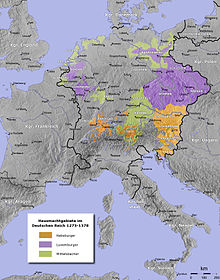Louis V, Duke of Bavaria
| Louis V | |
|---|---|
Beatrix of Świdnica |
Louis V, called the Brandenburger (May 1315 – 18 September 1361), a member of the
Family history
Louis V was the eldest son of King Louis IV of Germany and his first wife, Beatrice of Świdnica. His father, Duke of Bavaria since 1294, had been elected king in 1314, rivalled by the Habsburg anti-king Frederick the Fair. He had to defend his rights in a lengthy throne quarrel, finally defeated Frederick's forces in the 1322 Battle of Mühldorf, and in 1328 received the Imperial crown; though not by the pope but by the "Roman people" led by Sciarra Colonna.
Margrave of Brandenburg

Upon his victory at Mühldorf, the king took the occasion to seize the princeless
To further strengthen the rule of the Wittelsbach dynasty in Northern Germany, Margrave Louis was married to Margaret (1305–1340), the eldest daughter of King Christopher II of Denmark, in 1324. Nevertheless, the Wittelsbach rule in Brandenburg never earned much popular support. As a consequence of the murder of Provost Nikolaus von Bernau by Berlin and Cölln citizens in 1325, the twin-town was punished with a papal interdict. Subsequently, the public unrest led to a resurgence of the centuries-long Brandenburg–Pomeranian conflict from 1328 onwards. The Pomeranian dukes had to withdraw from the Uckermark region after a series of battles throughout the late 1320s and early 1330s.[2] In 1330, they took their duchy as a papal fief to circumvent the Brandenburg claims. In 1336, Louis joined the Teutonic Knights on a crusade in Lithuania, indirectly causing the mass suicide of 4,000 Lithuanians at Pilėnai. In 1338, they finally concluded a peace with the Wittelsbach margrave, who renounced his claims on overlordship but maintained the right of succession.[3]
Having received the Brandenburg
From 1342 onwards, Margrave Louis mainly stayed in
Duke of Bavaria
When his father died in October 1347, Louis succeeded him as Duke of Bavaria as well as
Still banned, Margrave Louis could not apply for the German crown and his party tried to move the Wettin margrave Frederick II of Meissen to the acceptance of the royal title, however, he mistrusted the inconstancy of his voters and rejected the request. Louis then negotiated with his father's ally King Edward III of England to compete against the new Luxembourg king Charles IV, the elder brother of Margaret's husband John Henry. Edward was indeed elected on 10 January 1348 at Lahnstein, but resigned just four months later. Finally, the Wittelsbach party elected Count Günther von Schwarzburg as anti-king in 1349. Louis V successfully resisted Charles IV even though Günther von Schwarzburg's kingship failed. He managed to keep all possessions for the Wittelsbach dynasty until his death.
First Louis successfully repulsed an attack of Charles IV against Tyrol in 1347. In alliance with
Louis released Brandenburg in December 1351 to his brothers Louis VI and Otto V, in exchange for the sole rule of Upper Bavaria. Louis then combined the administration of Upper Bavaria and Tyrol, residing both in Munich and Meran. In 1349 and 1352 he issued two decrees to relieve the consequences of the plague and enabled Jews to re-settle in the Upper Bavarian lands.
Louis VI the Roman, Brandeburg margrave between 1351 and 1365, had to re-establish the Wittelsbach rule against the opposition of the Ascanians, which he accomplished by 1355.[7] During this process, the Brandenburg-Pomeranian border in the Uckermark was finally settled in 1354.[7][8] With the Golden Bull of 1356, only the Palatinate branch of the Wittelsbach family and Louis VI the Roman as Margrave of Brandenburg were invested with the electoral dignity, which caused a new conflict between Louis V and Charles IV.
Duke Louis V maintained good relations with his Habsburg relatives and in 1352 helped arbitrate conflicts of Duke
Louis suddenly died in September 1361 in
Family and children
Louis was married two times.
- 1324: Margrete of Denmark (1305–1340), daughter of King Christopher II of Denmark
- 1342: Margaret, Countess of Tyrol (1318–1369), daughter of King Henry of Bohemia, wife of John Henry of Luxembourg (divorced in 1349)
- Hermann of Bavaria (1343–1360)
- Meinhard III (1344–1363), married 1359 with Margarete of Habsburg (1346–1366), daughter of Duke Albert II of Austria
- daughter
- daughter
Map
References
Sources
- Mollat, Guillaume (1965). The Popes at Avignon, 1305-1378. Harper & Rowe.
